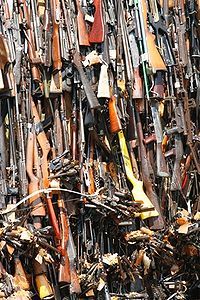Feinstein slated to reveal gun ban legislation in Jan.
Jan. 7, 2013
By Katy Grimes
When the 1994 federal assault weapons ban was signed into law, it was a reaction to a horrific act of violence. The resulting law regulated certain semiautomatic weapons and large ammunition magazines.
The law was allowed to expire in 2004, but not everyone was happy about it.
With the recent school shooting in Newtown, Conn. still fresh in the news, Sen. Dianne Feinstein, D-Calif., seized the opportunity to reintroduce the legislation banning certain weapons, but this time, made it far more stringent.
1994 assault-weapons ban — then and now
Adam Eisgrew was Senator Feinstein’s counsel for the Senate Judiciary Committee from 1993 to 1995 and worked on the original weapons ban bill. He recently wrote about the 1994 assault-weapons ban and Feinstein’s proposed 2013 legislation in the New York Times:
“The bill had three main components. The first was a list of well-known, deeply feared guns that were banned by name (like Uzis). The second banned the future manufacture and sale of any new semiautomatic weapon with a detachable magazine and more than two of several assault-style features (like a forward handgrip). The third and most critical section was Appendix A, which listed every single hunting rifle and shotgun in use at the time — there were hundreds — that didn’t run afoul of the features test in the second component. Those firearms were unequivocally exempted from the bill.”
Eisgrew advocates for making the new assault-weapons ban stronger in the light of the Newtown shootings.
“If we want to reimpose a permanent assault-weapons ban and restrict high capacity ammunition magazines, let’s include a new list of exempted rifles and shotguns used for recreational shooting in a new Appendix A (updated annually) and actively solicit input from the shooting community to make it work.”
Proposed legislation
On Jan. 22, Feinstein will formally introduce her new legislation, a much more sweeping bill than the last, and more stringent than any previously proposed legislation banning weapons. Second Amendment defenders characterize it as “a firebomb.”
Last week Vice President Joe Biden, who is heading a presidential task force on gun control, “guaranteed” sweeping legislation would be passed by the end of January.
If Feinstein’s legislation is any indication, many are saying that up to 75 percent of all handguns currently in circulation would be banned, along with 50 percent of all long guns and with anything that looks like a military-style weapon.
Gun owners would undergo a six-month license application process to keep existing AR-15s and other automatic weapons, have to be fingerprinted and undergo a background check by the FBI.
Summary of legislation
Here is a summary of the legislation as posted on Feinstein’s website:
1. Bans the sale, transfer, importation, or manufacturing of:
* 120 specifically-named firearms;
* Certain other semiautomatic rifles, handguns, shotguns that can accept a detachable magazine and have one or more military characteristics; and
* Semiautomatic rifles and handguns with a fixed magazine that can accept more than 10 rounds.
2. Strengthens the 1994 Assault Weapons Ban and various state bans by:
* Moving from a 2-characteristic test to a 1-characteristic test;
* Eliminating the easy-to-remove bayonet mounts and flash suppressors from the characteristics test; and
* Banning firearms with “thumbhole stocks” and “bullet buttons” to address attempts to “work around” prior bans.
3. Bans large-capacity ammunition feeding devices capable of accepting more than 10 rounds.
4. Protects legitimate hunters and the rights of existing gun owners by:
* Grandfathering weapons legally possessed on the date of enactment;
* Exempting over 900 specifically-named weapons used for hunting or sporting purposes; and
* Exempting antique, manually-operated, and permanently disabled weapons.
5. Requires that grandfathered weapons be registered under the National Firearms Act, to include:
* Background check of owner and any transferee;
* Type and serial number of the firearm;
* Positive identification, including photograph and fingerprint;
* Certification from local law enforcement of identity and that possession would not violate State or local law; and
* Dedicated funding for ATF to implement registration.
Related Articles
We’re all undocumented!
JUNE 24, 2010 By LAURA SUCHESKI California senators and assembly members gathered on the West Steps of the Capitol Wednesday
$11.1 billion water bond for 2014 stuck in muddy waters
Feb 11, 2013 By Wayne Lusvardi Is the third time the charm for an $11.1 billion water bond? Postponed two times by
More Democracy At Election Time
FEB. 2, 2011 by JOHN SEILER “All the ills of democracy can be cured by more democracy,” said Al Smith,



